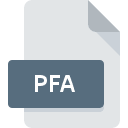.PFA File Extension

Printer Font ASCII File
| Developer | Adobe Systems |
| Popularity | |
| Category | Font Files |
| Format | .PFA |
| Cross Platform | Update Soon |
What is an PFA file?
Printer Font ASCII (.PFA) files are text files that contain font outlines used by printers. These files serve as a vital component in the printing process, enabling printers to accurately render text and graphics.
PFA files store font information in a human-readable ASCII format, making them accessible and editable using basic text editing tools.
More Information.
The PFA file format emerged as a part of the PostScript font standard introduced by Adobe. PostScript fonts were designed to accurately represent typefaces across various output devices, ensuring consistent rendering regardless of the printer or imaging device used.
PFA files contain font outlines defined in the PostScript language, which describe the shapes and characteristics of each glyph within a typeface.
Initially, PFA files were primarily used in professional printing environments, where precise typography and high-quality output were paramount.
Designers and typesetters relied on PFA files to ensure that their creations would reproduce faithfully on different printing presses and devices.
Origin Of This File.
The origins of the PFA file format can be traced back to the early days of computer printing technology. As printers became more sophisticated, the need for standardized font formats arose.
Adobe, a pioneer in digital typography, developed the PostScript page description language (PS) in the 1980s, which revolutionized printing by enabling high-quality, device-independent output.
File Structure Technical Specification.
PFA files follow a straightforward structure defined by the PostScript font standard. At their core, these files consist of ASCII-encoded text that describes the vector outlines of each glyph in the font.
The outlines are defined using PostScript commands, which specify the coordinates and curves necessary to draw each character shape.
In addition to glyph outlines, PFA files may include metadata such as font name, copyright information, encoding tables, and kerning data.
This metadata provides essential information about the font and its usage, facilitating proper integration into printing workflows and software applications.
How to Convert the File?
Converting PFA files to other formats or vice versa is possible using various software tools and utilities. One common conversion is from PFA to OpenType (.otf) or TrueType (.ttf) formats, which are widely supported in modern digital environments.
Similarly, PFA files can be generated from existing fonts in TrueType or OpenType formats using specialized font conversion software.
To convert a PFA file to a different format, users can employ dedicated font conversion utilities available online or as standalone software applications.
These tools typically provide options for selecting input and output formats, adjusting conversion settings, and processing multiple files simultaneously.
Advantages And Disadvantages.
Advantages:
- Precision: PFA files accurately describe the shape of each glyph, ensuring high-quality output with crisp, clean lines.
- Compatibility: PostScript fonts, including those stored in PFA format, are widely supported across different platforms and printing systems.
- Editability: Since PFA files are text-based, they can be easily modified using standard text editing tools, allowing for customization and optimization.
- Scalability: PostScript fonts are resolution-independent, meaning they can be scaled to any size without loss of quality, making them suitable for both small and large print applications.
Disadvantages:
- File Size: PFA files can be relatively large, especially for complex typefaces with many glyphs, which may impact storage and transmission efficiency.
- Complexity: Understanding and editing PFA files requires familiarity with the PostScript language, which can be daunting for users without specialized knowledge.
- Licensing: Some fonts stored in PFA format may be subject to licensing restrictions, limiting their use in certain contexts or requiring additional permissions for distribution.
How to Open PFA?
Open In Windows
Using Notepad:
- Right-click on the PFA file.
- Select “Open with” and choose “Notepad” from the list.
- The PFA file will open in Notepad, allowing you to view and edit its contents.
Open In Linux
Using Text Editor:
- Open your preferred text editor (e.g., Gedit, Vim, Emacs).
- Go to “File” and select “Open.”
- Navigate to the location of the PFA file and open it.
- The PFA file will be displayed in the text editor for viewing and editing.
Open In MAC
Using TextEdit:
- Locate the PFA file in Finder.
- Right-click on the file and select “Open With” > “TextEdit.”
- The PFA file will open in TextEdit, where you can view and make changes to its content.
Open In Android
Using a Text Editor App:
- Install a text editor app from the Google Play Store (e.g., Jota Text Editor, QuickEdit Text Editor).
- Open the text editor app and navigate to the location of the PFA file.
- Tap on the PFA file to open it within the text editor for viewing and editing.
Open In IOS
Using Text Editing Apps:
- Install a text editing app from the App Store (e.g., Textastic Code Editor, TextEdit+ Code Editor).
- Open the text editing app and navigate to the location of the PFA file.
- Tap on the PFA file to open it within the text editor for viewing and editing.













